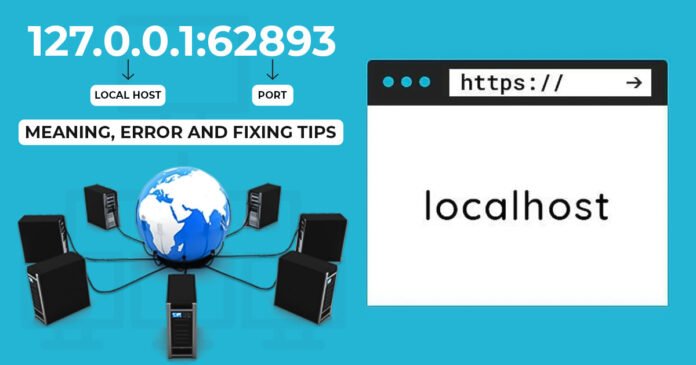Introduction to 127.0.0.1
127.0.0.1 is a special IP address known as the loopback address. It is used to establish an IP connection to the same machine or computer being used by the end-user. This address is part of the IPv4 standard and is designated for use in testing and development environments. When you use 127.0.0.1, you’re essentially sending network traffic to your own computer. This can be incredibly useful for developers and network administrators who need to test applications without affecting external networks.
Understanding Ports
Definition of a Port

In networking, a port is a virtual point where network connections start and end. Ports allow computers to differentiate between different kinds of traffic (e.g., web traffic, email traffic) and direct them to the appropriate services.
Range of Ports
Ports are divided into three main ranges:
- Well-Known Ports (0-1023): These are reserved for system or well-known services (e.g., HTTP uses port 80).
- Registered Ports (1024-49151): These are assigned by IANA for specific services upon application.
- Dynamic/Private Ports (49152-65535): These are used for private or temporary purposes, often by applications and services in the local network.
Specifics of Port 62893
Port 62893 falls into the dynamic/private port range. This means it can be used for any custom or temporary service. This flexibility makes it useful for developers who need to run multiple services on the same machine without conflicts.
Combining 127.0.0.1 Port with Port 62893
When you combine 127.0.0.1 with specific ports like 62893, you direct traffic to a particular service on your local machine. This is essential for testing and developing networked applications in an isolated environment.
Common Uses for 127.0.0.1:62893
Local Development and Testing
Developers often use 127.0.0.1 with different ports to simulate real-world scenarios without needing external servers. For instance, you might run a web server on 127.0.0.1:62893 to test a new website.
Configuration of Services
Various services such as web servers, databases, and other applications can be configured to listen on specific ports. This allows multiple services to run concurrently without interference.
Setting Up and Accessing 127.0.0.1:62893
How to Set Up a Service on Port 62893
To set up a service on port 62893, follow these steps:
- Choose a Service: Decide which service you want to run (e.g., a web server).
- Configure the Service: Adjust the service’s configuration files to listen on 127.0.0.1:62893.
- Start the Service: Launch the service and verify it’s running by checking the logs or using network tools.
Accessing the Service
To access the service, open a web browser or a network client and enter http://127.0.0.1:62893. This should connect you to the service running on that port.
Security Considerations
Importance of Security
Even though 127.0.0.1 is local, securing services running on it is crucial to prevent unauthorized access.
While port forwarding is a powerful tool, it introduces potential security risks. Here are some best practices to mitigate these risks:
- Use Strong Passwords: Ensure that devices and services behind forwarded ports have strong, unique passwords.
- Update Firmware: Keep router firmware up to date to protect against known vulnerabilities.
- Disable UPnP: If not required, disable UPnP to prevent unauthorized port forwarding.
- Monitor Network Traffic: Regularly monitor network traffic to detect any unusual activity that might indicate a security breach.
- Limit Access: Restrict access to forwarded ports using firewall rules to allow only trusted IP addresses.
Potential Risks
- Unauthorized Access: Local services could be accessed by malicious software if not properly secured.
- Data Leakage: Sensitive information might be exposed if the service is not configured securely.
Best Practices
- Use Firewalls: Configure your firewall to block unwanted traffic.
- Authentication: Implement robust authentication mechanisms.
- Encryption: Use encryption to protect data transmitted to and from the service.
Troubleshooting Common Issues
Connection Refused Errors
If you encounter a “connection refused” error, it may be due to:
- Service Not Running: Ensure the service is running.
- Firewall Blocking: Check if the firewall is blocking the port.
- Port Conflicts: Verify that no other service is using the same port.
Port Conflicts
If multiple services are trying to use the same port, change the port number for one of the services.
Firewall Settings
Adjust firewall settings to allow traffic on the specific port. This can usually be done through your operating system’s firewall configuration tool.
Use Cases and Examples
Web Development
Developers often run local web servers on ports like 62893 to test web applications before deployment.
Database Testing
Local databases can be configured to listen on specific ports for development and testing purposes.
Custom Applications
Custom applications or services might use 127.0.0.1:62893 for inter-process communication on the same machine.
Advanced Topics
Loopback Interface Configuration
Different operating systems handle loopback interfaces differently. Configuring loopback interfaces can enhance local network performance.
Port Forwarding
Port forwarding is a network technique that allows external devices to access services on a local network through a router. This process maps an external port on a router to an internal IP address and port on a local network. By doing this, it enables users to run servers or services behind a router and make them accessible from the internet.
How Port Forwarding Works
When a device on the internet sends data to a specific port on the router’s external IP address, the router forwards that data to the designated internal IP address and port. This mechanism ensures that the data reaches the correct device and service within the local network.
Types of Port Forwarding
- Static Port Forwarding: This type involves permanently mapping an external port to an internal port. It’s commonly used for services that need to be consistently accessible, such as web servers and FTP servers.
- Dynamic Port Forwarding: This type is more flexible and can change the mapping dynamically based on the needs of the applications. It’s often used in scenarios where the internal services might change frequently.
- Universal Plug and Play (UPnP): This is an automatic port forwarding system that allows devices on a network to configure the router to forward ports without user intervention. It’s convenient but can pose security risks if not properly managed.
Docker and Virtualization
Docker containers and virtual machines often use 127.0.0.1 for internal communication between containers and the host machine.
Conclusion
In conclusion, understanding 127.0.0.1 and ports like 62893 is essential for developers and network administrators. They provide a safe and isolated environment for testing and development. By securing and properly configuring these local services, one can effectively simulate and troubleshoot real-world scenarios. Mastering the use of loopback addresses and ports can significantly improve the efficiency and security of your development workflow.
Also read: Get_ready_bell:client_pulse, Features, Benefits, and More


